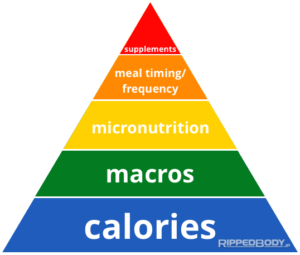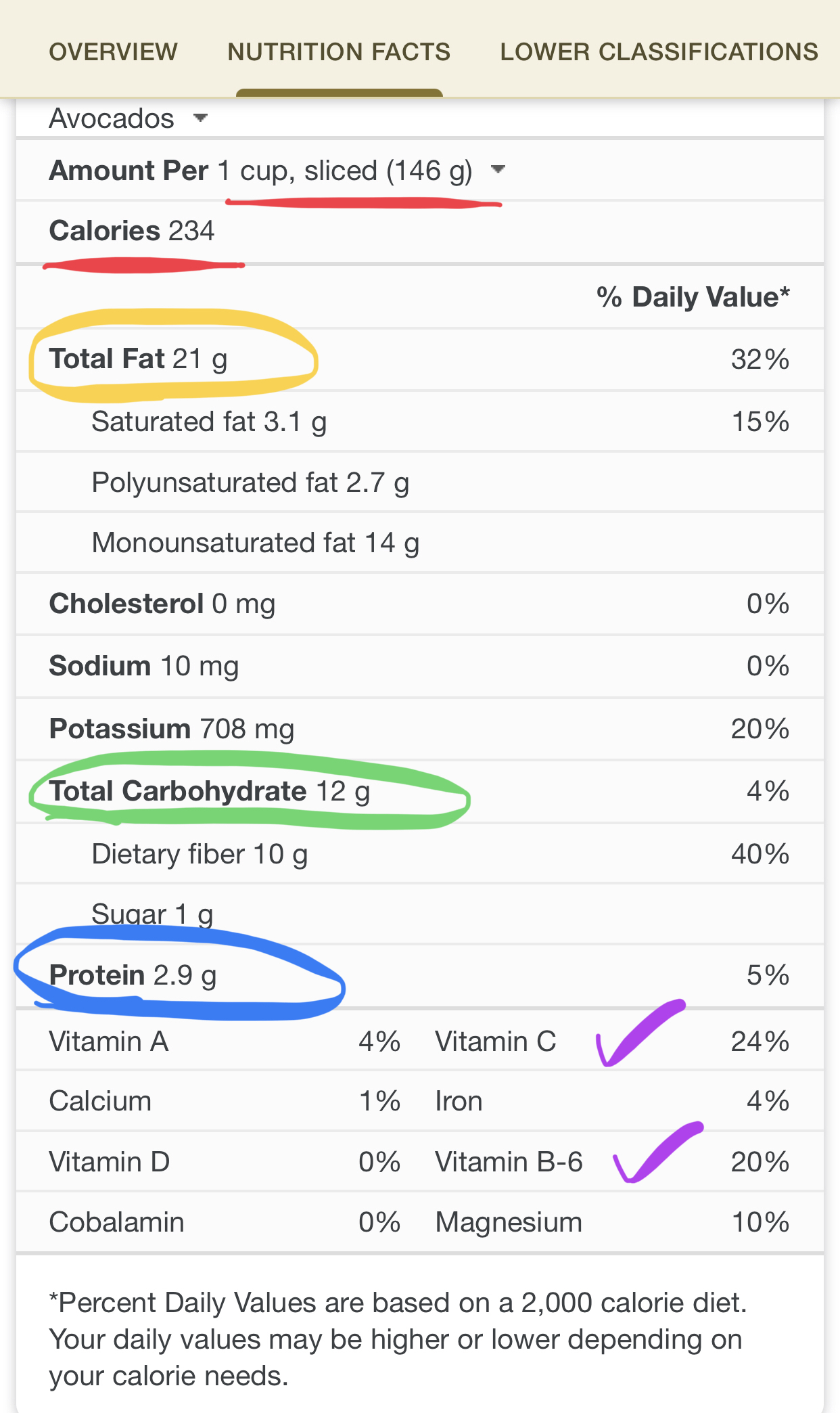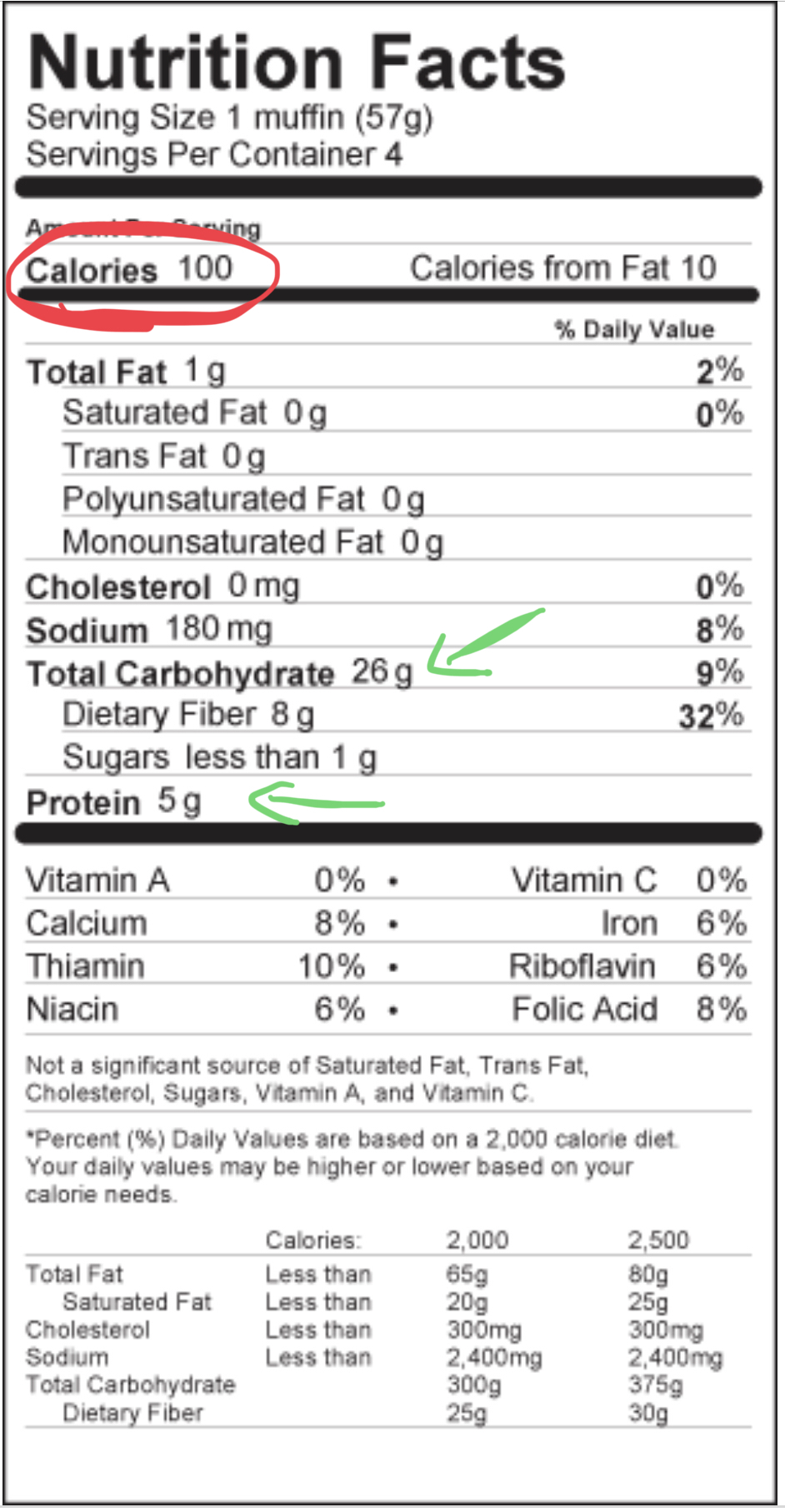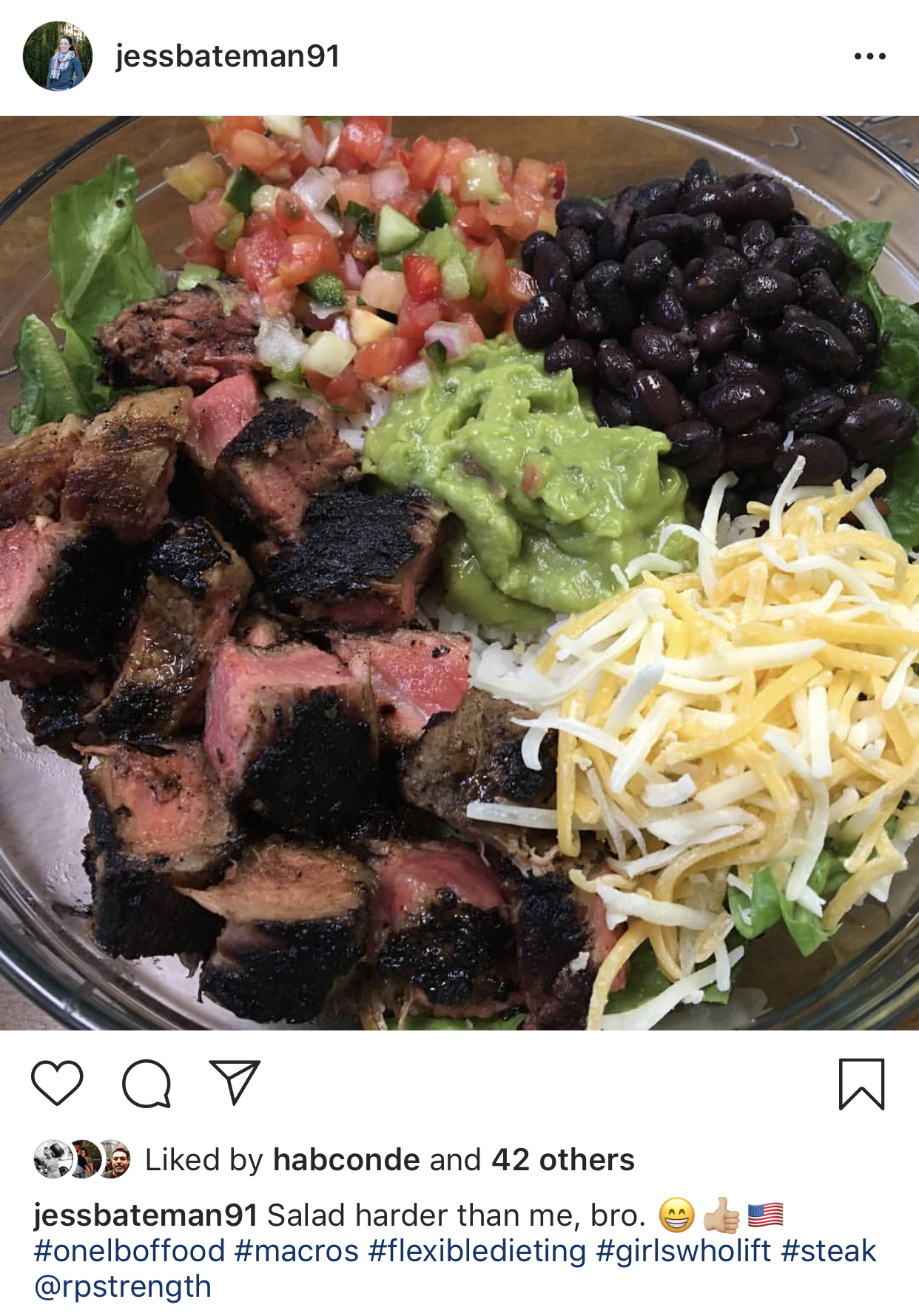It can seem just about impossible to keep up with all the latest diet trends. And many of them totally contradict each other: Keto. Low Fat. Carnivore. Vegetarian. Paleo. Flexible Dieting. Intermittent Fasting. Six Meals a Day… Where are you supposed to start?! In this post, we wanted to give you some nutrition basics that can help you sort through the latest fads and trends about nutrition and dieting. At the most simple level, nutrition basics are there to help you choose a healthy and sustainable diet that meets your goals.
When you get on social media, you can be crushed under an avalanche of fad diets but very few daily nutrition basics. There are diets designed to drop weight quickly. Some diets are designed for adding muscles mass. There are even ones that claim to cure autoimmune disease and cancer (Hot take: they don’t. Please see a medical professional).
It’s no wonder I get emails and DMs every day from people confused about how to navigate the world of nutrition. The common thread amongst all of these questions is confusion about the very basics of nutrition and diet choices. So I thought that I’d like to take some time to explain some basic nutrition terms to help all of us
What is a Diet?
Merriam-Webster defines a diet as “food and drinks regularly provided or consumed.” That’s it. No more; No less. When most people talk about a diet, they generally mean some sort of nutritional plan that eliminates foods of one variety in order to restrict calories and lose weight. But dieting is much more complex than that. Sure, some diets help you lose weight. But they can also be designed around changing body composition while maintaining weight, or even gaining weight, depending on your goals. This is mostly dependant on Calories are consumed and how many Calories are burned on a daily basis.
A diet doesn’t have to be restrictive. Some times it can be helpful to add healthy foods to your diet. Filling your plate half up with fresh vegetables is a great way to lose weight while actually feeling full. In fact, some diets like this can be difficult to maintain simply because you have to eat so many vegetables that you can feel stuffed without actually finishing your whole meal! Doesn’t that sound better than starving yourself?

What is a Calorie?
A Calorie is not some magical substance that makes you fat. It is simply a unit used to measure energy. A lowercase calorie is the amount of energy needed to raise one gram of water by 1º Celsius. Technically, food is measured in kilocalories (meaning the energy needed to raise one kilogram of water by 1º Celsius) so it gets an uppercase C in Calorie. With few exceptions, if you eat Calories in excess of what you use every day, you will gain weight. If you eat fewer calories, you will lose weight. There are some caveats to this, but that is going beyond the basics so we will talk about it at another time.
What’s a Macro?
Calories measure the energy available in the food we eat. Foods are made of one of three macronutrients (or “Macros”) for short. These include carbohydrates, protein, and fat. Previously, it was thought that alcohol didn’t have any Calories, but more recently scientists have found our bodies treat alcohol as its own macronutrient. Each of these four represent a different amount of energy. I won’t bore you with the chemistry, but protein and carbohydrates each equal four Calories per gram. Alcohol contains seven Calories per gram, and fat is the most nutrient-dense with nine Calories per gram. When we talk about “hitting your Macros for the day”, we refer to the total amount and ratio of Fats, Proteins, and Carbohydrates to meet your nutritional goals.
Some foods are commonly referred to as these macronutrients. Rice is a “carb”. Chicken is a “protein”. And olive oil is a “fat”. This is one way I see people getting hung up on how to weigh and measure food. These foods are referred to as these macronutrients because this makes up the bulk of their nutritional content. Using these examples, rice has a tiny amount of fat and protein per gram, and chicken breast has a bit of fat, too. They are also made up of water and other biological substances. This is why one gram of carbohydrates equals four Calories, but one gram of rice is not four calories. That’s why you need conversion tables for diets focused on certain amounts of the different Macros.
There are a variety of websites and apps that can do this for you. One of the most convenient is MyFitness Pal since the basic version is free. Just input your serving size, and it will tell you how many calories/carbs/proteins/fats are in what’s on your plate!
Carbohydrates
The main function of carbohydrates is to provide fuel. Long chains of carbohydrates are stored in muscle and the liver, and broken down into glucose whenever energy in needed. Your body’s primary source of energy comes from oxidizing glucose to release the energy stored in the chemical bonds. That energy is captured by your tissues and used for everything from muscle contraction to nerve function. Your brain almost exclusively uses glucose for energy. Common sources of carbohydrates include bread, rice, potatoes, fruits, and vegetables.
When your stores of carbohydrates run very low, your brain can switch to using ketones as an alternative fuel for activity. These ketones are produced in the liver and include acetone and two other ketone compounds. This is the basis for the Keto diet, which also deserves its own separate article as it goes well beyond nutrition basics.
Fats
Fats are the main component of cell membranes and are important macronutrients for your body’s daily function. The fatty areas of your body, like your belly or thighs, are different. That’s where fat is stored for later use and is called adipose tissue. Fat also serves as the storage site for some vitamins and cushioning for vital organs. Fat can be burned by your cells for energy also, but are not the preferred energy source. However, when you exercise, fatty acids are mobilized and sent through the bloodstream to your muscles as additional fuel, especially during longer cardio events. Common dietary sources of fats include oils, dairy, nuts, fish, and meats.
Protein
Proteins are the building blocks of your body. Proteins “do” things either as muscle, enzymes, or as support structures. Did you know that proteins actually make up a large percentage of your bone structure? Protein can be converted by the liver into glucose, through a process called “gluconeogenesis”. But protein is usually used for building, repair, and recycling of functional body tissues. Foods containing large amounts of proteins include fish, meat, poultry, seeds, eggs, dairy, beans, lentils, and legumes. Protein supplementation is often used to help gain muscle mass, and it can possibly help decrease muscle soreness after exercise. Many popular diets now focus on higher proportions of protein in the diet. And while they can be very effective at rapid weight loss, but the long term safety of these diets is concerning based on scientific review. But more on those in another post!
What’s a Micronutrient?
The term “micronutrients” refers to the minerals and vitamins we get (ideally) from our food. These include things like Vitamin C, B Vitamins, Vitamin D, Zinc, Magnesium, and Iron. We need small amounts of these daily (compared to the volume of macronutrients needed). They are important for growth, metabolism, brain development, immune response, and many other critical functions of the body.
You may have heard of the Recommended Daily Intake, or RDI, before. The RDI is a guideline for the amounts of each vitamin needed each day to sustain a healthy adult. Now, before you find the most expensive daily vitamin supplement, these numbers are TOTALLY reasonable to get from real food on a daily basis, as long as you’re eating a few servings of colorful veggies and fruit in each day.
You know what they say, “Close counts in horseshoes, hand grenades, and RDI.” Right? Okay, so that’s not how the actual saying goes but maybe it should. So, you eat 120% of your daily Vitamin C one day and only 70% of your potassium. The next day you get 140% of your Vitamin A and 100% of your potassium but only 50% of your Vitamin C. As long as you’re averaging closer to that 100% mark over several days of food, no need to worry about coming down with Scurvy.
Metabolic Rate
Your metabolic rate is the number of calories you burn in a day. This is dependent on factors including your weight, gender, age, and activity level. In order to be successful in a diet, you need to find balance in your portion sizes. Maintenance Calorie recommendations vary, but major health organizations like the NHS and NIH recommend ranges from 1800-2500 calories. However, one of the best things you can do for yourself is to find a Registered Dietitian or other licensed medical professionals who can do a Resting Metabolic Rate, or RMR, test. This establishes how many calories you could burn in a day if you’re just chilling out on the couch.
For safe dieting, the Resting Metabolic Rate is preferable to the Basal Metabolic Rate, or BMR. Your Basal Metabolic Rate is essentially the number of calories you burn if you’re comatose. Which I’m going to safely assume doesn’t apply to any of you reading this! The RMR test is painless and relatively inexpensive, ranging $150-250. It provides invaluable information for those serious about their nutrition. So, even if you can’t afford a full ongoing program with a Registered Dietician, at least you have scientific data to base your own calorie goals on whether you want to lose, maintain, or gain weight.
How to Read a Nutrition Label
Nutrition labels can be confusing. Some diets claim that, as long as your food doesn’t have a label, you can eat it in any quantity you desire and not worry about your weight. But, guess what, everything has nutrition information, regardless of whether you got an apple from the produce section or sour patch kids from the candy aisle. One might keep you full longer, but they can be pretty similar when it comes to the amount of carbs and calories per serving.
So, to show you how to read a nutrition label, let’s take a look a the unassuming and trendy Avocado:
“Amount Per” is code for “serving size”, which means 1 cup of sliced avocado (or 146 grams if you’re weighing it out on a scale) equals 234 Calories.
In this same amount of avocado, there are 21 grams of total fat (which includes the saturated, polyunsaturated, and monounsaturated fat amounts). There are 12 grams of carbohydrates, 10 of which come from fiber, and a measly 3 grams of protein.
Under the information for the macronutrients, you’ll find the “micro” information, which is where you will see the amount of vitamins in the serving size of food. A full cup of avocado has 24% of your Vitamin C RDI and 20% of your recommended Vitamin B-6.
Remember, this is for a full cup of avocado. If you’re only having a quarter-cup, you’d really be having 5 grams of fat, 3 grams of carbs, and basically no protein. Your micronutrients would also be cut by 75%. Avocados serve as an excellent source of “healthy” fat, but they shouldn’t be used as your main source of vitamins, as other fruits and vegetables have a higher percentage of micronutrients compared to their total calorie impact on your day!
Why Is It Important to Track Macros and Calories?
If the “Calorie is King”, as they say, why is it necessary to keep track of your macros, too?
The short answer: companies can legally lie (to an extent) about the exact calorie content in their products by rounding up or down to influence consumer choices about their products. I’ve definitely used “Light” products before when dieting to keep my food volume up and some of my favorite foods in the rotation, but don’t assume a product is actually the most Calorie-conscious option just because they slapped “Light” on the packaging.
My favorite example is from a well-known national bakery and their English Muffins. Here is the label for their “Light” version of their product:

The total Calories provided is 100 Calories per serving. Sounds pretty good, right? Well, here’s the thing. This number is supposed to be the total Calories coming from the protein, carbs, and fat in their product. If you scan below the Calories, you’ll see it lists 1 gram of Fat, 26 grams of Carbohydrates, and 5 grams of Protein.
Not bad, right? But let’s add this up. 1 Fat = 9 Calories, 26 Carbs = 104 Calories, and 5 Protein = 20 Calories. Together, that’s 133 total Calories. But they rounded down to 100 to appeal to the consumers.
Now, sure, 35 Calories won’t make or break your whole diet here and there. But it can add up when consumers are only making choices by whether or not the company has something labelled as the “Light” option.
Don’t Trust the Packaging
What makes this worse is when you compare this nutrition information to
this same company’s Regular Multi-grain Muffins:

To the right, you’ll see the total Calories listed is 120 Calories (which is already less than the actual Calories in the Light Muffins).
It makes sense that these regular muffins have fewer total Calories, because there is one fewer gram of both carbs and protein that the Light muffins. Added up, this becomes 125 actual Calories.
Once again, if this is the only accidental added Calories in your day, not a big deal. But it can be frustrating when someone thinks they’re purchasing a healthier option for themselves and adding 50 extra Calories per food item in some cases. These add up over the course of a day or week of dieting and might account for slower than expected progress.
Common Nutrition Misconceptions
Fat Doesn’t Make You Fat but Neither Do Carbs
This is honestly one of my biggest pet peeves of the dieting industry. Nobody wins when certain foods are demonized. It can cause anxiety and eating disorders and I could write a whole post about that. *Steps off soapbox*
Your body needs protein, fats, and carbohydrates in varying amounts for very specific purposes. That’s why we include all of them in nutrition basics. Fat is needed to make hormones, store energy, and provide necessary insulation for vital organs. Your body uses carbohydrates to make ATP, which is a molecule used to fuel nearly all chemical reactions in the cell. Protein is needed to help build and replace structures in the body, as well as used in enzymes and hormones.
The exact numbers may vary from person to person, but certain amounts of each macronutrient are needed for the body to function optimally. Too few carbohydrates can lead to decreased athletic performance and mental function. Too low fat can lead to hormonal deficiencies. Not enough protein can cause dysfunction of the musculoskeletal system, leading to muscle cramping, poor healing, and bone density loss. Too much of any of these macros can also have negative health effects. At the end of the day, moderation truly is key.
Dieting Doesn’t Have to be Hard or Boring
Here’s the big secret to healthy eating. It doesn’t have to be complicated. You don’t need to deprive yourself of food that tastes good. Many fad diets simply find a way to help you cut out a large number of calories. Unfortunately, this kind of diet is not usually sustainable.
The best kind of diet is one you can sustain. Stick to the nutrition basics. It can be beneficial to get rapid weight loss from a popular diet. But the most sustainable method to weight control is to then find little ways to bend your regular diet to the healthier side. I’m from Wisconsin and, therefore, culturally indoctrinated to love all things cheese, so I make compromises by switching from cooking in Olive Oil or butter to store-brand Pam. Another favorite of mine is to substitute a recipe from sour cream to greek yogurt. Little changes like this can make a huge difference.
Got a recipe you love and not quite sure how to adapt it? Chances are someone else has already done the heavy lifting for you. Pinterest and the internet at large are a huge resource for recipe swaps to help you keep some of your favorite foods in your diet. The more you’re able to modify what you’re currently eating instead of making some drastic switch, the more likely you are to stick to a diet plan instead of derailing your progress entirely when a cheat meal turns into #cheatweek.

Dieting Doesn’t Have to be Expensive
You don’t need fancy shakes, vitamins, or all organic food. Nutrition basics are just that; nothing fancy! To keep costs down, buy fresh fruits and veggies when they’re “in season” and buy frozen when they’re not. Frozen meat is generally cheaper, as well, and is an easy way to avoid food waste. To keep an eye on your fat intake (where your calories can drastically increase accidentally), stick to lean cuts of meat: 90% fat-free or leaner when possible. Rice, whole wheat pasta, and potatoes are healthy carbs that give you a lot of food volume for the price!
Yes, a healthy diet is more expensive than a steady stream of Ramen noodles. But it’s an investment that pays off in the long-run when you consider the healthcare costs of a poor diet. And it’s much cheaper than regular drive-thru runs!
Nutrition 101
I know that was a bit of an information dump, so here’s a brief recap:
Nutrition doesn’t have to be complicated, and you don’t need some crazy fad diet plan to lose weight. The best diets are ones that can be adapted from your current habits and let you lose weight at a steady rate.
Calories matter. Don’t think because you shopped on the “perimeter of the grocery store” that whatever you eat has no consequences for your weight loss goals. Nobody has ever gotten fat from eating fruit, but they have from the accidental Calorie bomb of eating 1/2 C of Peanut Butter with their apple slices.
Micronutrients matter. Shopping around the perimeter of the grocery store can still be a useful tool, because your vitamins and minerals matter. Your overall health improves when you’re eating enough fruit and veggies!
Don’t Fall for Dieting Myths. You don’t have to totally deprive yourself of all of life’s joys just to lose a little weight. The majority of us can’t handle eating baked chicken, rice, and broccoli 5 meals a day. Little adjustments to your normal diet routine can go a long way. There are no “bad” foods, just bad portions.
If you’re still struggling with finding the right Calorie balance/portion sizes for you, find a Registered Dietician to help you get started. Even if you can’t afford regular visits, establishing a Resting Metabolic Rate and having that initial consultation is an invaluable tool that can help you self-navigate your weight loss (or weight gain) journey.
Remember: simple changes can be effective and prevent you from getting overwhelmed. Don’t get confused by all the hype on the internet. Stick to the basics and see just how much you can achieve! You’ve got this!

